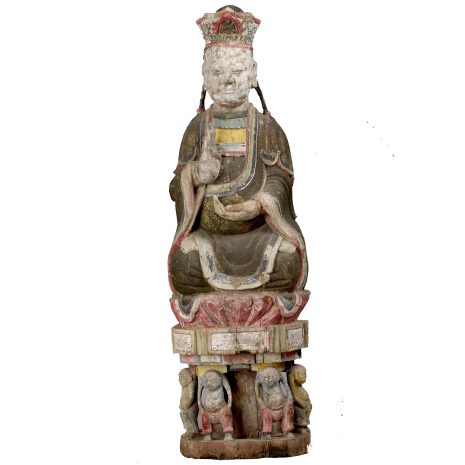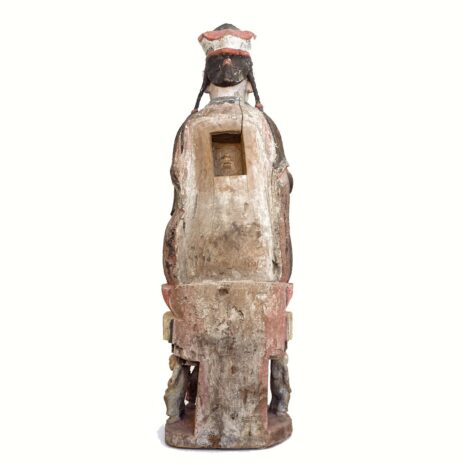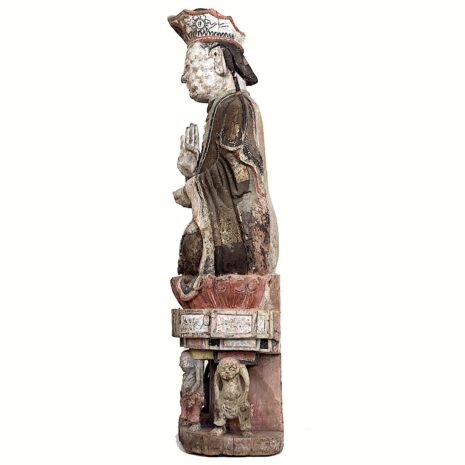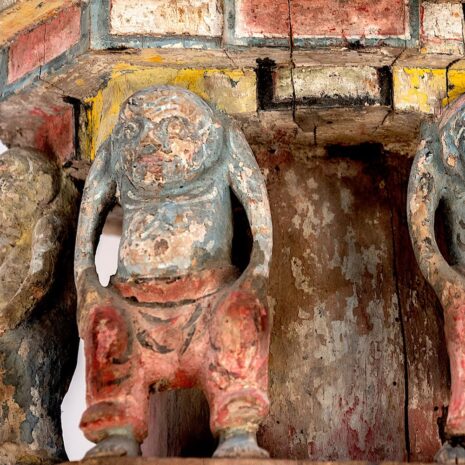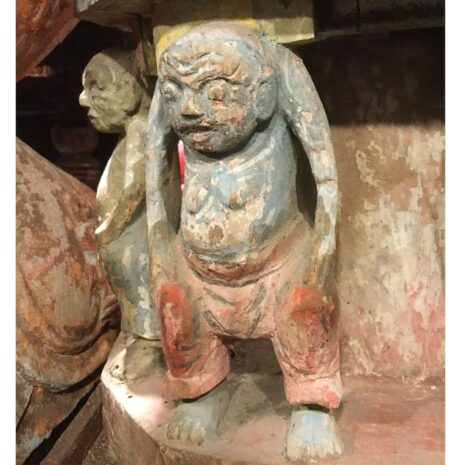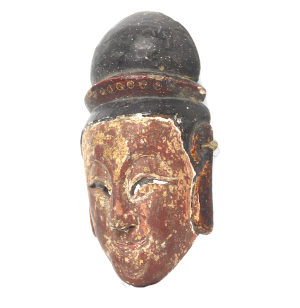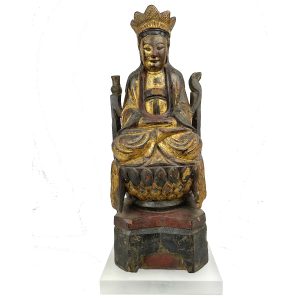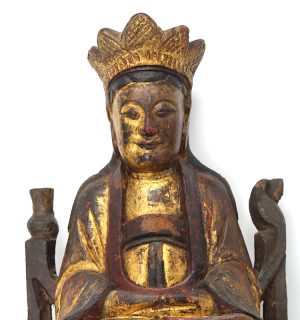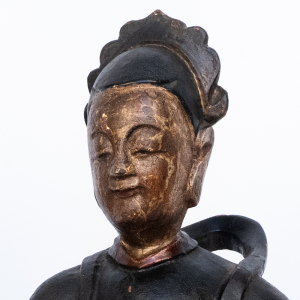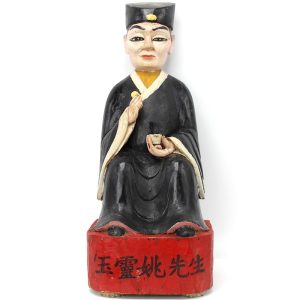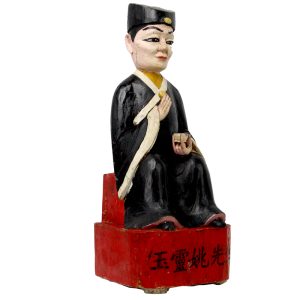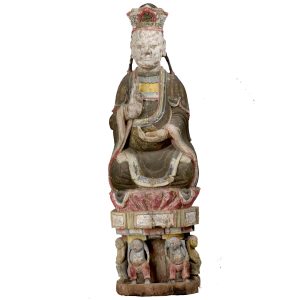Antique Guanyin Held Up by Demons, China (16208VRKE) $5800
$5,800.00
H: 45″ W: 17.75″ D: 11.5″ | FOR SHIPPING INFORMATION CONTACT US AT 213-568-3030
This outstanding Guanyin wood carving is an extremely rare image and displays a wonderful earthy blend of Mahayana and Tantric (Tibetan) Buddhism and spiritual and folk traditions that resonated with provincial populations. She sits on a lotus above a hexagonal throne right raised in abhaya mudra, lobed crown is centered with the Amitabha Buddha inside an aureole. The four agonized creatures struggling to hold the calm Guanyin on their shoulders is a unique Tantric visual representation of the triumph of Buddhism over ignorance. Probably placed in a community shrine or Guanyin temple, the rear is unpainted as it was displayed high against a wall and foreshortened to be viewed from below. With its admonitions about greed, aversion and ignorance it is a great metaphor for our times.
Description
Carved wood Guanyin images were enormously popular in China’s provincial regions created by local artisans who did not follow proscribed court artistic rules or iconography and integrated elements from Buddhist, Taoist and Popular Folk Religion traditions into a syncretic blend, one of the Great Chinese Goddesses (Irwin). Guanyin sits on a raised lotus rising from the base through and above the hexagonal lotus throne(padmapitha), left hand in meditation (dhyana-mudra) and the right raised in abhaya mudra symbolizing protection, peace and “have no fear” legs are in padmasana with the feet upward on the opposite thigh. Her lobed crown is centered with Amitabha inside a flaming aureole, normal Buddhist iconography. This image shows the influence of Tibetan Buddhism on Mahayana Buddhism during the Ming and Qing dynasties. Defense of Buddhism against ignorance and demonic forces is a concept more often seen in Tibetan, Nepalese and Tantric-Buddhism than Mahayana Buddhist representations where demons are viewed as forces and natural spirits that must be recognized, appeased and confronted by the living. Demons are not demons forever, but while in the lower realms they must “hold up” beings of the highest realms reminding us people may change from demons to higher realms and back in their constant evolutionary transition toward enlightenment. Demonic creatures are not harmful, they are only obstacles – greed, aversion, and ignorance – that each of us must respect, control and overcome through good deeds and thoughts, meditation, observing rituals and offerings of appeasement. Buddhist statues of demons in the realms of hell like these four grotesque creatures warn us to be more diligent in our spiritual efforts, thoughts and actions and follow the the Noble Eightfold Path. This antique-Chinese carving is in very good condition with normal losses consistent with age and use. Some areas were periodically retouched, especially her face, as was customary with Buddhist carvings, especially those from rural areas where paint easily faded in bad weather. The rear cavity (bung) indicates it was consecrated in an eye-opening ceremony by a Buddhist monk. This is part of the VA Collection of Buddhist-Art.
Click here for the Blog Consecrating Wooden Images to Imbue Them with A Life Force.
Sources:
Julia Hirsch, “The Monsters of Buddhism – Inside and Out” in Trycicle: The Buddhist Review, October 31, 2013.
John C Huntington and Dina Bangdel, The Circle of Bliss: Buddhist Meditational Art, Chicago, Serindia Publications, 2003.
Lee Irwin, “Divinity and Salvation: The Great Goddesses of China,” in Asian Folklore Studies, Indiana University, Vol. 49, 1990, pp 53-68.
Meher McArthur, Reading Buddhist Art: An Illustrated Guide to Buddhist Signs and Symbols, London, Thames and Hudson, 2002.
Chun-Fang Yu, Kuan-yin: The Chinese Transformation of Avalokitesvara, New York, Columbia University Press, 2001.
Chun-Fang Yu, “Kuan-yin: The Chinese Transformation of Avalokitesvara” in Latter Days of the Law: Images of Chinese Buddhism 850-1850, Marsha Weidner, Ed. Honolulu, University of Hawaii Press, 1994, p.151-182.
Additional information
| Period | Antique, Qing Dynasty |
|---|---|
| Date | 18-19th Century |
| Materials and Technique | Wood |
| Dimensions (inches) | Ht: 45” W: 17.75” D: 11.5” |
| Dimensions (metric) | Ht: 114.3cm W: 45.08cm D: 229.21cm |
| Weight | 32 lbs |
| Condition | Very good, see description |
| Item Number | 16208VRKE |
| Shipping Box Size | This item is oversized. Call 213-568-3030 for shipping cost. |
